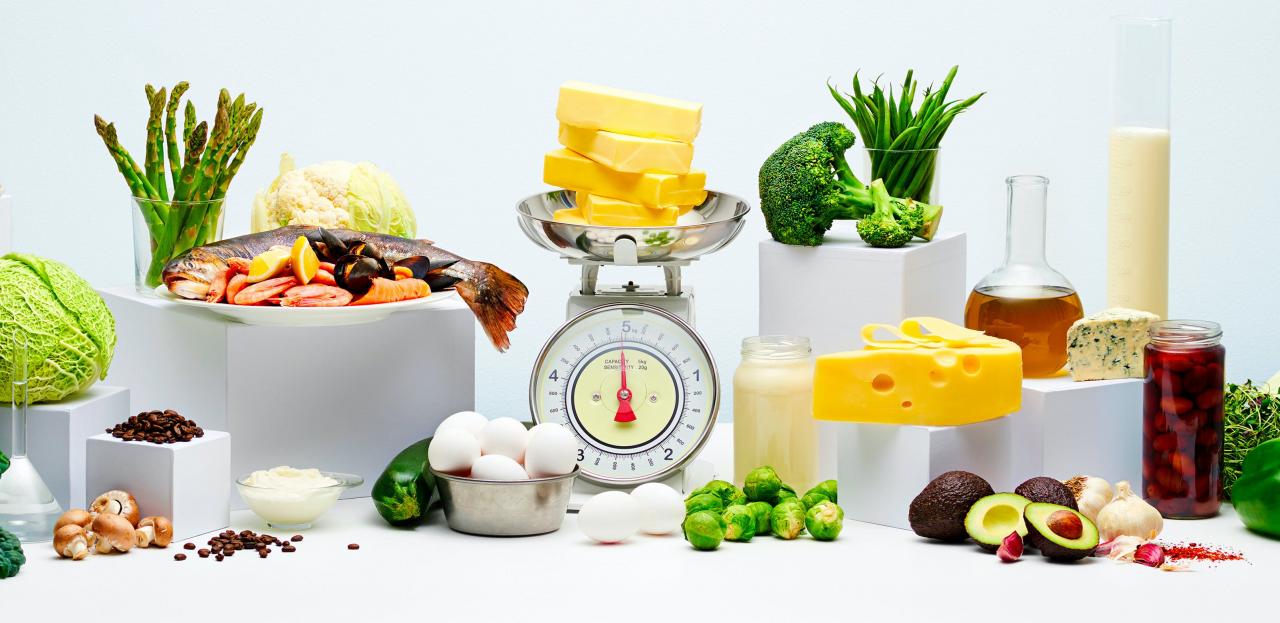The origins of the ketogenic diet go back further in history than one would think. As early as the beginning to the middle of the 20th century, research was carried out in connection with the treatment and prevention of epileptic seizures initially with pure fasting, later with a high-fat and low-carbohydrate diet.
It was quickly noticed that apparently the main reason for the Success is the drop in blood sugar levels from fasting. The same is achieved through a high-fat and low-carbohydrate diet.
It was Robert Coleman Atkins, an American cardiologist and nutritionist, who really brought the ketogenic diet to the general public’s attention. This happened in the form of the book “ Dr. Atkins’ New Diet Revolution “. Atkins describes a diet model divided into several phases, which is based on the provision of energy via ketone bodies and is intended to ensure significant weight loss over a longer period of time.

The ketogenic diet or nutrition is basically characterized by a very low carbohydrate intake, usually between 0-50g. The human body then switches the metabolism to the energy supply through ketone bodies, which it forms itself, since it does not get enough carbohydrates from outside. It should be noted that the amount of carbohydrates that you can take in and still stay in ketosis depends very much on your level of activity .
So it is possible that people who move very little and are not active in sports can only consume 10-20g of carbohydrates, and people who move a lot or are very active in sports (e.g. triathletes, marathon runners, etc. .), can even consume well over 50g of carbohydrates per day and the body still prefers the ketogenic path of energy supply.
For whom is a ketogenic diet suitable?
A ketogenic diet is primarily suitable for weight loss. This works in several ways. I will not go into the relatively rapid initial weight loss through the reduction of glycogen and water in the body, as it is not a matter of reducing the percentage of body fat. Not to be underestimated is the “shedding” of the first kilos when considering the motivation question of the dieter. In addition to generating energy from dietary fats and the body’s own fat reserves, a ketogenic diet also leads to a reduction in portion size and a longer feeling of satiety in most people, and thus in the long term to a reduced calorie intake this method, they say that the ketogenic diet works well in treating epileptic seizures.
Animal studies have shown that the diet can also have advantages against aging, anti-inflammatory measures and in the fight against cancer .
Others There are advantages in the sporting sector. It was shown that in the field of powerlifting / powerlifting a ketogenic diet is equivalent to a diet with a higher carbohydrate intake, but enables a change in body composition in the sense of body fat reduction without significant loss of strength or muscle mass.
This is important in all sports where weight classes are involved. [8] In the related area of muscle building, good results can also be achieved, and that with a simultaneous reduction in body fat percentage. In endurance sports too, athletes benefit from a ketogenic diet. If you compare the amount of available energy (glycogen storage: approx. 2000 kcal vs. fat storage approx. 40,000 kcal) it quickly makes sense that the body is trained as well as possible to use fat or ketone bodies as an energy source.
Is a ketogenic-diet unhealthy?
If one observes a few key points, this question can be answered for a large part of the population answered with a resounding no. People who suffer from serious underlying illnesses should always clarify a change in diet with their doctor first.

Ketogenic diet: when fat & protein determine the menu
From a health point of view, the greatest advantage of a ketogenic diet is constant and lower Blood sugar level. If very little or no carbohydrates are eaten, the body produces the required amount of carbohydrates from the other two macronutrients, fat and protein.
Since efficiency in the human body always plays a decisive role but only as much glucose is produced by the liver to keep blood sugar levels at a low normal level and organs, for example the brain to supply sufficient glucose.
Diabetes
If you suffer from type 1 or type 2 diabetes, you should only go on the ketogenic diet after you have had a clarifying discussion with your doctor and you agree that it is “O.K.” received from this. In this context, a similar sounding word, namely “ketoacidosis”, is often used. The life-threatening ketoacidosis should not be confused with the completely normal metabolic process of ketosis. Ketoacidosis can develop in type 1 diabetes when there is an excessive lack of insulin. The accumulation of glucose and ketones in the blood can then increase to such an extent that the pH value shifts towards the acidic level.
A change in the blood pH value is and is only provided for within very narrow limits in the human body If these are exceeded, they can quickly become life-threatening. This is also the case with ketoacidosis. The body then tries to excrete glucose and ketones in the urine, dehydration occurs, which intensifies the previous effects and a potentially fatal cycle develops if no treatment is undertaken.
The danger exists if it is handled improperly the disease type 1 diabetes and can occur regardless of the diet chosen. Cases of ketoacidosis have occurred in type 2 diabetes, but these have been linked to certain new drugs. Apart from that, excellent treatment successes were achieved in type 2 diabetics, in experiments the blood sugar level was stabilized and the body weight was reduced by up to 10% .
Cardiovascular diseases
It is now clear that the decades-long fear of fat and cholesterol as a congestion of the blood vessels that lead to an imminent heart attack or stroke is completely unfounded. There is no medically recognizable connection between animal fat sources and cardiovascular diseases. Only hydrogenated and highly processed fats, as well as vegetable fats in larger quantities, pose a real risk to the human body.
Fortunately, the use of these products in the food industry has declined so much in recent years. A negative example that is still very popular are the potato chips. These contain a lot of sunflower oil, which contains a lot of omega-6 fatty acids, which on the one hand promote inflammation and on the other hand shift the balance between omega-6 and omega-3 fatty acids. Therefore, such products should not only be avoided in the context of a ketogenic diet, but generally.
But why do you find cholesterol deposits in patients with corresponding clinical pictures? The body uses the cholesterol in damaged vessels like a kind of plaster in order to repair triggered inflammations and micro-injuries beforehand with other substances, we will come to that in a moment. One can well imagine that a vessel can become narrower in such places. If you put a sticking plaster on your finger, it will be thicker afterwards than without sticking plaster.
Not a lot with a sticking plaster, of course, but if you consider that over the decades, more and more injuries to the vessels due to improper nutrition and Lifestyles arise without the body even having the chance to remove the “old patches”, it quickly becomes clear how high blood pressure, vascular blockages, etc. arise.
But how are the vessels actually damaged? Investigations point a clear direction. Relationships between high sugar consumption and negative effects on the cardiovascular system have been revealed. A diet rich in sugar promotes inflammation processes in the body and thus also on blood vessel walls.
In summary, there is no reason to advise against a ketogenic diet, on the contrary.
How can you design a ketogenic diet sensibly?
Basically you should use the following foods in a ketogenic diet: eggs, meat , Fish, cheese, nuts, vegetables. If the ketogenic adaptation has already taken place, fruit can be consumed in smaller quantities. Berries are particularly suitable here. Even a kiwi every now and then doesn’t do any harm if you have an eye on the total intake of carbohydrates.
Contrary to popular belief, it is very possible to eat larger quantities of vegetables during a ketogenic diet. There are a number of different types of vegetables, such as Spinach, radishes, or celery, which are very low in carbon hydrates (10). The same applies to nuts, you should just be careful not to consume varieties such as cashews, which have a higher carbohydrate content, or only in small amounts.
If the basic diet is right, no calorie counting or food diary is necessary. The body gets used to smaller portions with a higher energy density relatively quickly. For non-athletes, about 1g protein / kg body weight is sufficient, which can also be achieved or exceeded without any problems without diet tracking and supplements. For athletes, depending on the level of activity, 1.5-2g protein / kg body weight .
Exceptional cases are of course extreme loads , such as in ultra runs or similar Overall, the whole thing leads to a (comparatively) stress-free diet. You are less hungry, need smaller portions, are full longer. Symptoms of fatigue due to a sharp rise in blood sugar are a thing of the past.

You should (almost) completely avoid sugar and as far as possible no sweeteners, both of which can distort the natural feeling of hunger. I would recommend thinking about a slight increase in salt intake, this can possibly reduce the so-called “keto flu” during the conversion or adaptation phase or make it disappear. People who are sensitive to salt (e.g. increased blood pressure) should discuss such a procedure with their doctor.
Here is a brief overview of an example day of a ketogenic diet:
- In the morning: eggs with a little bacon, cucumber and radishes, a few berries
- At noon: steak with herb butter, lamb’s lettuce with a little olive oil and spices
- In the evening: cheese, Ham, walnuts, olives
Whey protein can easily be added after training. This is also the best time to eat smaller amounts of carbohydrates (I take around 10g of carbohydrates with around 45g of protein).
The accumulation of diarrhea
If you are on a ketogenic diet, you will find that you want to go to the bathroom much more often during the day. This could originate from the gallbladder, the organ that produces bile to aid in the loss of fat in the diet.
Especially foods that consist almost exclusively of fat (e.g. butter, marscapone) can trigger this effect in the short term. The amount that is well tolerated is very individual. If this becomes a problem, the fat intake can simply be shifted in favor of a little more protein and low-carb vegetables or the triggering foods can be replaced with other foods.
Diarrhea can also be due to a lack of fiber in the diet be due. For example, if you replace all fiber-rich foods, which are usually also foods rich in carbohydrates, with foods that consist almost exclusively of fat and protein from one day to the next, this can mean too rapid a change for the body.
A good example would be the switch from a vegan high-carb diet to the ketogenic diet. In such cases, I would recommend a slower entry into the new form of nutrition in order to give the body the time it needs to be able to adapt.
The targeted use of dietary fiber is also possible, e.g. Psyllium husks . Personally, I would not recommend this and instead proceed by adjusting the basic diet to make the symptoms disappear.
It can also be caused by intolerance to dairy products or artificial sweeteners – Things you may have been eating more since moving on to a high-fat, low-carb lifestyle. You have to be aware that the ketogenic transition is a big wall for your body and that it only gets used to the transition after a long period of time.
One often speaks of the so-called ” keto flu “. The individual symptoms of the ketogenic flu are listed in detail on ketogen-und-fit.de.
This needs to be reconsidered. A ketogenic diet or diet can also be designed to be healthy or unhealthy.
